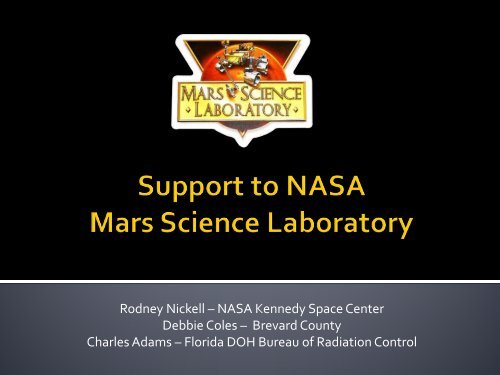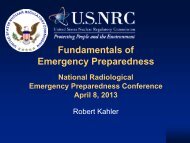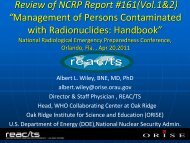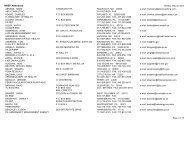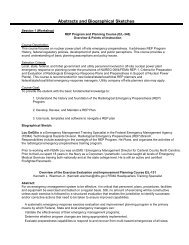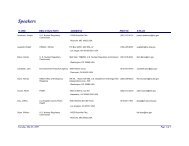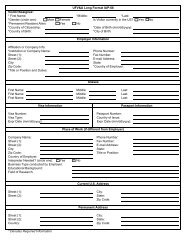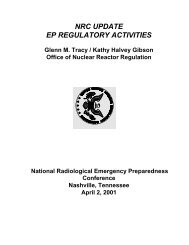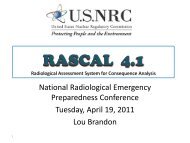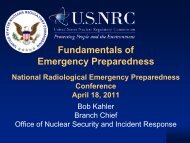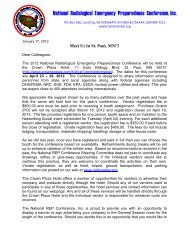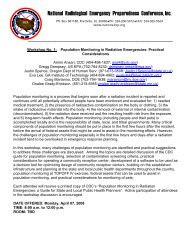Session 8_Support to NASA Mars Science ... - National REP
Session 8_Support to NASA Mars Science ... - National REP
Session 8_Support to NASA Mars Science ... - National REP
- No tags were found...
You also want an ePaper? Increase the reach of your titles
YUMPU automatically turns print PDFs into web optimized ePapers that Google loves.
Heat generated through alphadecay of Plu<strong>to</strong>nium 238 passingthrough thermocouplesproduces approximately 100watts of power <strong>to</strong> charge roverbatteries.Official Use Only
• Florida is a “County Rule State” - CountyCommissioners have the authority andresponsibility <strong>to</strong> protect their citizens –Delegated <strong>to</strong> Emergency Management (EM)Direc<strong>to</strong>r• If the Governor declares a State ofEmergency that authority and responsibilitypasses <strong>to</strong> the Governor• The governor’s representative is delegatedthat authority – EM person located at RADCCor Unified Command
• State Comprehensive Emergency PlanAnnex A, Appendix V details functions andresponsibilities for federal agencies, stateagencies and local govt’s in 50 mile radius.• Bureau Standard Operating Proceduredescribes Bureau response and PAGs• No federal funds are provided
• Governor's Rep at RADCC• 10-15 Person Team at Unified Commandwhen established• SEOC usually not activated for launch, but inmoni<strong>to</strong>ring mode
• Plans• Brevard County Comprehensive Emergency Management Plan(BC CEMP) with a Radiological Contingency Plan for SpaceLaunches Annex• Mission Specific Brevard County Radiological Contingency Planintegrated with KSC/<strong>NASA</strong>/DOE/USAF/State As defined inCEMP and operational briefings• Procedures• EOC is activated for a launch and is prepared <strong>to</strong> issue warnings,alerts and protective actions if required• Risk Communication Training and Briefings• Coordina<strong>to</strong>r Hospital Emergency Room and Pre-hospital EMStraining through REAC/TS• Command and Control – County through a Multi-agencyCoordination Center <strong>to</strong> the RADCC (Unified CoordinationGroup)
• ClearChannelOutdoor hasmade spaceavailable on7 boards inBrevard and2 in OrangeCounty
• Procedures cont.• Communications include:▪ Via Radio <strong>to</strong> PSAPs, First Responders, and hospitals▪ Via call notifications system (reverse 911)▪ Emergency Alert System▪ Digital Bill Boards▪ Twitter, Facebook and other social media• Funding• Protection of the Public, through Alerting and Warning, isa basic core responsibility of Emergency Management.The County funds all preparedness, training, and responsefor local agencies.• There is no funding for response from the FederalGovernment.
• Response• Traffic Control Points• Security for off-site moni<strong>to</strong>ring sites• Continuous media updates for the public• Security if there is physical off site impacts• Emergency medical support• A location for Unified Command off-site• Activate Brevard County CEMP and LaunchSpecific Plan for the MSL
• Objectives – What will it do?• Facts• Features• Limited time <strong>to</strong> Launch
2011Strategy: Follow the water, assess habitability, return a sample, prepare for humans.MSLconcept: Mobile labora<strong>to</strong>ry <strong>to</strong> assess habitability
Explore and quantitatively assess a local region on <strong>Mars</strong>’ surface as a potentialhabitat for life, past or present.• Assessment of present habitability requires:– An evaluation of the characteristics of the environment and the processesthat influence it from microscopic <strong>to</strong> regional scales.– A comparison of these characteristics with what is known about thecapacity of life, as we know it, <strong>to</strong> exist in such environments.• Determination of past habitability has the added requirement of inferringenvironments and processes in the past from observation in the present.• Such assessments require integration of a wide variety of chemical, physical, andgeological measurements and analyses.• These analyses would be accomplished by a diverse set of instruments, asophisticated sampling system, and a rover capable of bringing the payload <strong>to</strong> arange of sites and supporting it over one <strong>Mars</strong> year at a carefully chosen landingsite.
ENTRY, DESCENT, LANDING• Guided entry and controlled,powered “sky crane” descent• 20-km diameter landing ellipseCRUISE/APPROACH• 10-12 month cruise• Arrive N. hemisphere summer(L s =120-150)• Discovery responsive for landingsites ±60º latitude,
MSL Mission Overview (cont’d)
MastCamobserves thegeologicalstructures andfeatures withinthe vicinity of theroverAPXS determines thechemical composition ofrocks, soils, and processedsamples<strong>Mars</strong> Handheld Lens Imager(MAHLI) characterizes the his<strong>to</strong>ryand processes recorded ingeologic materials encounteredby MSLChemCam performs elemental analysesthrough laser-induced breakdownspectroscopyChemistry and Mineralogy (CheMin) performsquantitative mineralogy and elementalcomposition
Dynamic Albedo of Neutrons(DAN) measures the abundanceof hydrogen (e.g., in water orhydrated minerals) within 1meter of the surfaceSAM Suite Instruments-Quadrupole Mass Spectrometer (QMS)-Gas Chroma<strong>to</strong>graph (GC)-Tunable Laser Spectrometer (TLS)<strong>Mars</strong> Descent Imager(MARDI) provides detailedimagery of the MSL landingregionRadiationAssessmentDetec<strong>to</strong>r(RAD)characterizes theradiationenvironmen<strong>to</strong>n thesurface of<strong>Mars</strong>Rover EnvironmentalMoni<strong>to</strong>ring Station(REMS) measures themeteorological and UVradiationenvironments.SampleAcquisition,SampleProcessing andHandling(SA/SPaH)Process rockcores, smallpebbles, orregolith in<strong>to</strong>smaller particlesand deliver theprocessedmaterial <strong>to</strong> theanalytical labinstruments
USAF C-17 Used for Transport of <strong>Mars</strong> <strong>Science</strong> Labora<strong>to</strong>ry Rover <strong>to</strong> KSC
• Launch Site Radiological Control Center (RADCC)• Coordinating Agency Management Group (CMG)• Joint Information Center (JIC)• Pre-deployed Field Moni<strong>to</strong>ring Capabilities on-site& Off-Site• Environmental Continuous Air Moni<strong>to</strong>ring System –ECAMS• Field Radiation Moni<strong>to</strong>ring Teams• Consequence Management Home Team – CMHT
RADCCCMGAssessment Command & Control CenterJICRADCC• Moni<strong>to</strong>ring Assessment from ECAMs &Field Teams• Plum Projection From NARAC using45 SW Weather Data• Protective Action RecommendationsCMG• Senior Management Reps from <strong>NASA</strong>,DOE, EPA, FEMA, State of FL & CountyEOC’sJIC• PAO’s from <strong>NASA</strong>, DOE, 45 SW, Launch35Vehicle, EPA, State & County
Field Moni<strong>to</strong>ring Teams• On-site & Off-Site deployment of field moni<strong>to</strong>ring teams equippedwith FIDLER detec<strong>to</strong>rs, Alpha survey meters, and hi volume airsamplers. Field teams made up of personnel from <strong>NASA</strong> KSC, DOE,Air Force, and State of Florida Bureau of Radiological Health.Instrument readings will be electronically sent <strong>to</strong> the RADCC &CMHT RAMS servers via use of DOE Tables and MPCD’s.
Legend:Fxx = Offsite ECAMNxx = Onsite ECAM
T+45 min0:45ECAM 5 14:45(pCi-s)/m3: 163,000SDEV: 17 %ECAM-5 Coast Guard500450Pu-238 Air Concentration - pCi/m340035030025020015010050014:00 14:30 15:00 15:30 16:00 16:30 17:00Time (EST)
• Emergency Response Organization– Unified Command– State / County EOC– Other Federal agencies41
RAMS Overview – Mission and Primary Functions• Provides centralized collection and management of all dataused during a response <strong>to</strong> a nuclear or radiological event• Provides information management and analysis support <strong>to</strong>scientific personnel• <strong>Support</strong>s production of work products (i.e. Maps)• Provides integration and data exchange between multipleresponse assets, technologies, and personnel
NARAC: <strong>National</strong> AtmosphericRadiological Advisory CapabilityNARAC can provide Consequence Management (CM) information for a widerange of atmospheric hazards and release types including:• Explosive dispersal of radiologicalmaterial• Nuclear explosions• Toxic industrial chemical spills• Fires• Biological agents• Chemical agents• Nuclear power plant accidents
The CMHT:• Includes scientists who are experts inradiological assessment.• Assesses radiological dose, radiationrelated health effects and environmentalimpact, PAGs, mitigation processes, andconsequence management activities.• Provides interpretations of NARACpredictions.• Ensures the development, technicalintegrity, and scientific defensibility of allsummarized and assessed data products.• Performs assessment in the field, inconjunction with state and localrepresentatives.• Provides a reach-back capability <strong>to</strong>Consequence Management (CM) HomeTeams (RSL, NARAC, etc.).
• Improved capability for real-time data collection and reducing the human resourcesrequired <strong>to</strong> accomplish that data collection– Use of au<strong>to</strong>mated ECAMs with data telemetry capability• Taking advantage of CMHT concept <strong>to</strong> bridge initial emergency response phase of response– Back-up assessment capabilities supported by <strong>NASA</strong> ECAM downlink station at NARACand RAMS downlink at Remote Sensing Lab
Combined <strong>NASA</strong>, DOE, Air Force, State & County assets &personnel are working <strong>to</strong>gether <strong>to</strong> insure a robust deployment willbe in place <strong>to</strong> make prompt & comprehensive assessments andtake appropriate protective actions


